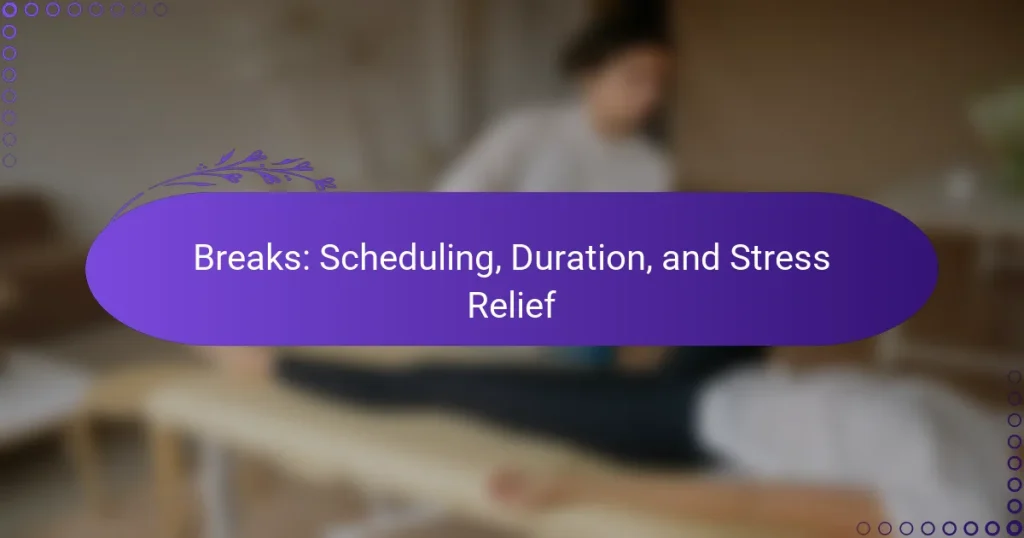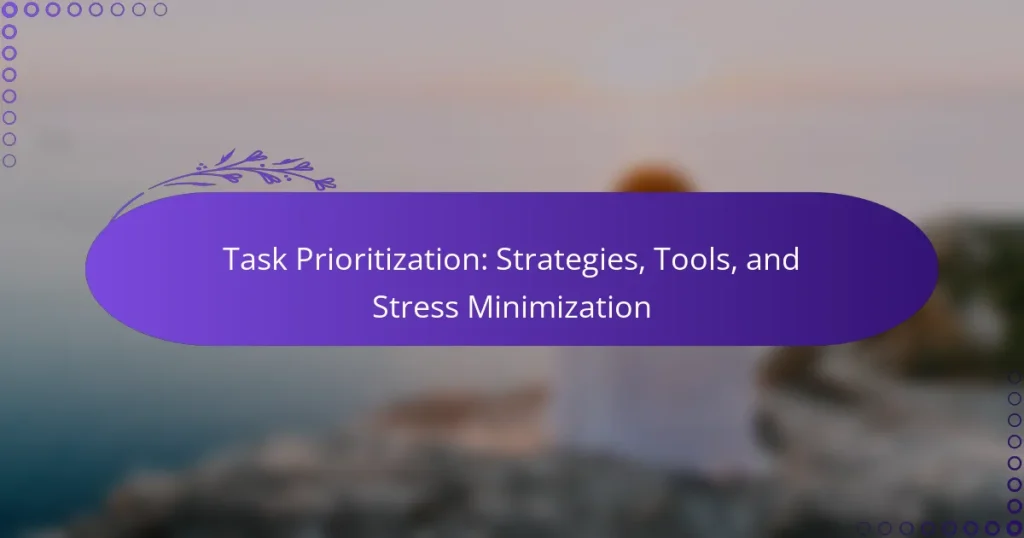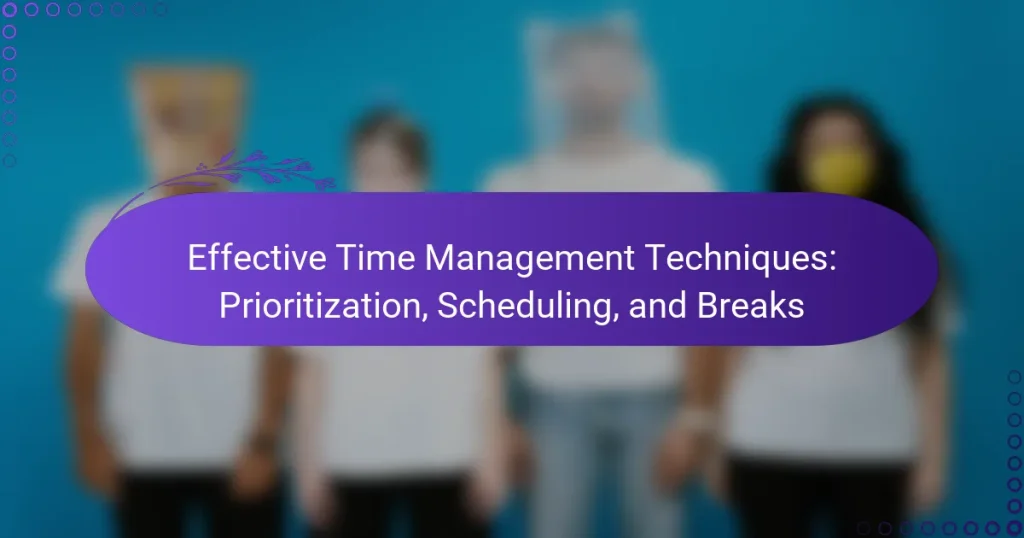Effective time management is essential for reducing stress and enhancing productivity in our daily lives. By prioritizing tasks and organizing responsibilities, individuals can create a balanced approach that alleviates the pressure of overwhelming workloads. Implementing structured techniques allows for clearer focus and better allocation of time, ultimately leading to a more manageable and fulfilling routine.
Task Prioritization: Strategies, Tools, and Stress Minimization
Pomodoro Technique: Focus, Timing, and Stress Reduction
Digital Tools: Efficiency, Organization, and Stress Reduction
Time Blocking: Structure, Focus, and Stress Management
Balanced Schedule: Planning, Flexibility, and Downtime
Effective Time Management Techniques: Prioritization, Scheduling, and Breaks
What are effective time management techniques for stress relief?
Effective time management techniques can significantly reduce stress by helping individuals prioritize tasks and allocate their time wisely. By implementing structured methods, you can enhance productivity and create a more balanced approach to your daily responsibilities.
Pomodoro Technique
The Pomodoro Technique involves breaking work into intervals, typically 25 minutes long, followed by a short break. This method promotes sustained focus and prevents burnout by allowing regular rest periods. After completing four intervals, take a longer break of 15-30 minutes to recharge.
To implement this technique, use a timer to track your intervals and breaks. This structured approach can help you maintain concentration and manage distractions effectively.
Time Blocking
Time blocking is a scheduling method where you allocate specific blocks of time for different tasks or activities throughout your day. By dedicating time slots to particular responsibilities, you create a visual roadmap that helps prioritize your workload and minimize procrastination.
Consider using a digital calendar or planner to set aside time for both work-related tasks and personal activities. This method can help ensure that you balance your professional and personal life, reducing stress associated with overlapping commitments.
Prioritization Matrix
The Prioritization Matrix, often referred to as the Eisenhower Box, helps you categorize tasks based on urgency and importance. This technique divides tasks into four quadrants: urgent and important, important but not urgent, urgent but not important, and neither urgent nor important.
By focusing on what truly matters, you can streamline your efforts and reduce the feeling of being overwhelmed. Regularly reassess your tasks to ensure you are prioritizing effectively and adjusting as necessary.
Task Batching
Task batching involves grouping similar tasks together to minimize context switching and improve efficiency. By handling similar activities in one go, you can maintain focus and reduce the time spent transitioning between different types of work.
For example, set aside specific times for responding to emails, making phone calls, or completing reports. This approach can lead to greater productivity and a more organized workflow, ultimately lowering stress levels.
Mind Mapping
Mind mapping is a visual technique used to organize thoughts and ideas around a central concept. This method allows you to brainstorm and structure information in a way that highlights relationships and priorities, making it easier to manage complex projects.
To create a mind map, start with a central idea and branch out with related tasks and concepts. This visual representation can clarify your objectives and help you see the bigger picture, reducing anxiety about what needs to be done.
How can I implement time management strategies in my daily routine?
Implementing time management strategies in your daily routine involves organizing tasks, setting priorities, and allocating specific time slots for activities. By doing so, you can reduce stress and enhance productivity, leading to a more balanced life.
Daily Planning
Daily planning is essential for effective time management. Start each day by listing tasks you need to accomplish, prioritizing them based on urgency and importance. Consider using a planner or digital calendar to visualize your day.
Allocate specific time blocks for each task, allowing for breaks in between to maintain focus. A common approach is the Pomodoro Technique, where you work for 25 minutes and take a 5-minute break, helping to sustain energy and concentration.
Setting SMART Goals
Setting SMART goals—Specific, Measurable, Achievable, Relevant, and Time-bound—can significantly enhance your time management. Clearly defined goals provide direction and help you stay focused on what truly matters.
For example, instead of saying “I want to get fit,” a SMART goal would be “I will exercise for 30 minutes, five times a week.” This clarity helps you track progress and adjust your plans as needed, making it easier to stay committed.
Using Digital Tools
Digital tools can streamline your time management efforts. Applications like Trello, Asana, or Todoist allow you to organize tasks, set deadlines, and collaborate with others efficiently. These tools often come with reminders and progress tracking features.
When choosing a tool, consider your specific needs and preferences. Some people prefer simple to-do lists, while others may benefit from more complex project management software. Experiment with a few options to find what works best for you.
What are the benefits of time management for reducing stress?
Effective time management significantly lowers stress levels by providing structure and clarity in daily tasks. By prioritizing responsibilities and allocating time wisely, individuals can avoid last-minute rushes and overwhelming workloads.
Improved Focus
Time management enhances focus by allowing individuals to dedicate specific blocks of time to particular tasks. This minimizes distractions and fosters a deeper engagement with the work at hand. Techniques such as the Pomodoro Technique, where work is divided into intervals, can help maintain concentration.
To improve focus, consider setting clear goals for each work session. Use tools like timers or apps to track progress and stay on task, ensuring that you are not easily sidetracked by interruptions.
Increased Productivity
By organizing tasks and setting deadlines, time management boosts productivity. When individuals know what needs to be done and when, they can work more efficiently and effectively. Prioritizing tasks based on urgency and importance can lead to completing more work in less time.
To maximize productivity, create a daily or weekly planner that outlines tasks and deadlines. Regularly review and adjust your plan to accommodate changing priorities, ensuring that you remain on track without feeling overwhelmed.
Better Work-Life Balance
Effective time management contributes to a healthier work-life balance by allowing individuals to allocate time for both professional and personal activities. By setting boundaries around work hours, people can ensure they have time for relaxation and family, which is essential for overall well-being.
To achieve a better balance, establish a clear end to your workday and stick to it. Schedule personal activities just as you would work commitments, ensuring that you dedicate time to hobbies, exercise, and social interactions to reduce stress and enhance life satisfaction.
What tools can assist with time management for stress relief?
Several tools can enhance time management, ultimately aiding in stress relief. These tools help organize tasks, track time, and improve productivity, allowing individuals to focus on what matters most.
Trello
Trello is a visual project management tool that uses boards, lists, and cards to organize tasks. Users can create boards for different projects and move cards representing tasks through various stages, providing a clear overview of progress.
To maximize Trello’s effectiveness, set up boards for specific goals and use labels to prioritize tasks. Regularly review and update your boards to stay on track and avoid overwhelm.
Todoist
Todoist is a task management app that allows users to create to-do lists, set deadlines, and prioritize tasks. Its intuitive interface makes it easy to add tasks quickly and categorize them by projects or labels.
For effective use, break larger tasks into smaller, manageable steps and set realistic deadlines. Utilize the recurring task feature for routine activities to maintain consistency without added stress.
RescueTime
RescueTime is a time-tracking tool that monitors how users spend their time on digital devices. It provides insights into productivity patterns, helping users identify distractions and areas for improvement.
To benefit from RescueTime, set specific productivity goals and review weekly reports to adjust habits. This awareness can lead to better time allocation and reduced stress from unproductive activities.
How does time management impact mental health?
Effective time management significantly enhances mental health by reducing stress and improving overall well-being. By organizing tasks and prioritizing responsibilities, individuals can create a balanced schedule that minimizes overwhelm and fosters a sense of accomplishment.
Reduces Anxiety
Time management helps reduce anxiety by providing structure and predictability in daily life. When tasks are planned and deadlines are set, individuals can avoid the last-minute rush that often leads to stress. For instance, breaking larger projects into smaller, manageable tasks can alleviate feelings of being overwhelmed.
Establishing a daily routine can also contribute to lower anxiety levels. Allocating specific times for work, relaxation, and self-care ensures that individuals have dedicated moments to recharge, which is essential for mental clarity and emotional stability.
Enhances Control
By mastering time management, individuals gain a greater sense of control over their lives. This control can lead to increased confidence and reduced feelings of helplessness. When people can prioritize effectively, they are less likely to feel at the mercy of external demands and pressures.
To enhance this sense of control, consider using tools like planners or digital apps to track tasks and deadlines. Setting realistic goals and regularly reviewing progress can also reinforce a proactive mindset, allowing individuals to adjust their plans as needed without feeling overwhelmed.






